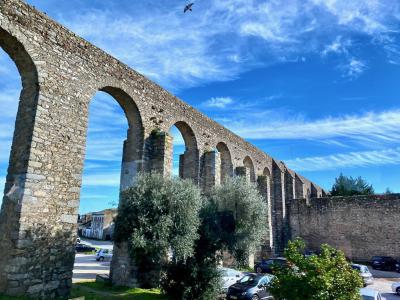
Agua de Prata Aqueduct (Silver Water Aqueduct), Evora
The Silver Water Aqueduct was constructed during the reign of King João III. This intricate feat of architecture was designed to provide the city of Évora with a reliable water supply. The aqueduct was inaugurated in 1537 and remains a functional conduit for water even today, making it a rare example of an engineering marvel from its era that still serves its original purpose.
The aqueduct's origin point is the springs located in Graça do Divor, situated within the premises of the São Bento de Castris Convent. These springs, with their initial source traced to Herdade das Figueiras de Lobo, provide the water that the aqueduct channels to the city of Évora. The aqueduct stretches across an impressive distance of approximately 18 kilometers, showcasing the ingenuity and dedication of the architects and engineers involved in its creation.
The mind behind the Silver Water Aqueduct's design was none other than Francisco de Arruda, a royal architect of great renown. His vision and meticulous planning led to the successful realization of this water transportation system, which played a crucial role in sustaining the city's inhabitants. The aqueduct's construction commenced in 1531 under the direct orders of King João III, who recognized the significance of securing a consistent water supply for Évora.
The inauguration of the aqueduct on March 28, 1537, marked a significant achievement in engineering and infrastructure development. Its enduring presence has garnered it a rightful place on the UNESCO World Heritage List as an integral component of the Historic Center of Évora. Furthermore, its historical importance has led to its classification as a National Monument since 1910.
The aqueduct's origin point is the springs located in Graça do Divor, situated within the premises of the São Bento de Castris Convent. These springs, with their initial source traced to Herdade das Figueiras de Lobo, provide the water that the aqueduct channels to the city of Évora. The aqueduct stretches across an impressive distance of approximately 18 kilometers, showcasing the ingenuity and dedication of the architects and engineers involved in its creation.
The mind behind the Silver Water Aqueduct's design was none other than Francisco de Arruda, a royal architect of great renown. His vision and meticulous planning led to the successful realization of this water transportation system, which played a crucial role in sustaining the city's inhabitants. The aqueduct's construction commenced in 1531 under the direct orders of King João III, who recognized the significance of securing a consistent water supply for Évora.
The inauguration of the aqueduct on March 28, 1537, marked a significant achievement in engineering and infrastructure development. Its enduring presence has garnered it a rightful place on the UNESCO World Heritage List as an integral component of the Historic Center of Évora. Furthermore, its historical importance has led to its classification as a National Monument since 1910.
Want to visit this sight? Check out these Self-Guided Walking Tours in Evora. Alternatively, you can download the mobile app "GPSmyCity: Walks in 1K+ Cities" from Apple App Store or Google Play Store. The app turns your mobile device to a personal tour guide and it works offline, so no data plan is needed when traveling abroad.
Agua de Prata Aqueduct (Silver Water Aqueduct) on Map
Sight Name: Agua de Prata Aqueduct (Silver Water Aqueduct)
Sight Location: Evora, Portugal (See walking tours in Evora)
Sight Type: Attraction/Landmark
Guide(s) Containing This Sight:
Sight Location: Evora, Portugal (See walking tours in Evora)
Sight Type: Attraction/Landmark
Guide(s) Containing This Sight:
Walking Tours in Evora, Portugal
Create Your Own Walk in Evora
Creating your own self-guided walk in Evora is easy and fun. Choose the city attractions that you want to see and a walk route map will be created just for you. You can even set your hotel as the start point of the walk.
Evora Introduction Walking Tour
Nestling in the sun-drenched Alentejo region of Portugal, Évora is a timeless gem in the heart of the country and one of its oldest and most enchanting cities.
The city's history spans over 5,000 years. The name Évora originates from the Celtic word "ebura," which means "of the yew trees."
The Romans conquered the place in 57 BC, shaping it into a vital town at... view more
Tour Duration: 2 Hour(s)
Travel Distance: 3.3 Km or 2.1 Miles
The city's history spans over 5,000 years. The name Évora originates from the Celtic word "ebura," which means "of the yew trees."
The Romans conquered the place in 57 BC, shaping it into a vital town at... view more
Tour Duration: 2 Hour(s)
Travel Distance: 3.3 Km or 2.1 Miles

